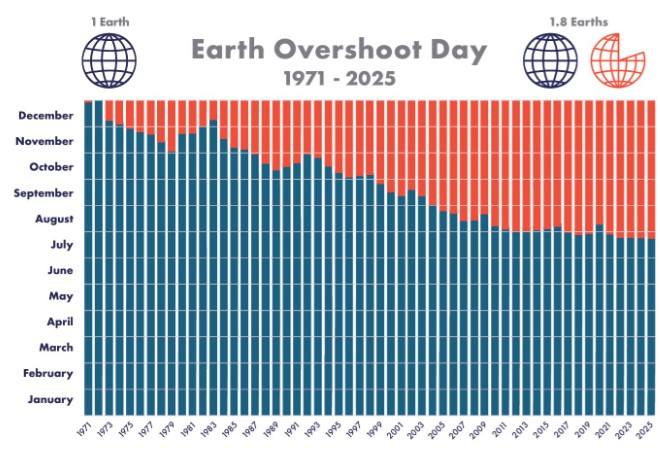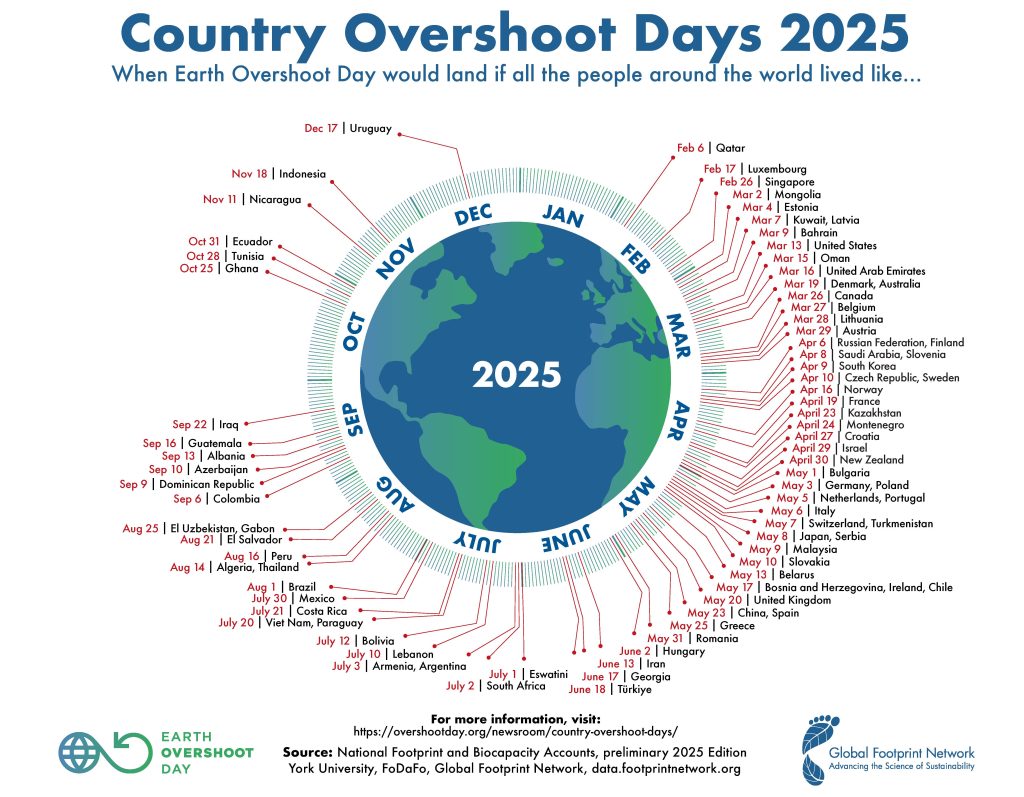Earth Overshoot Day marks the date when humanity’s demand for ecological resources and services exceeds what Earth can regenerate in that year. In 2025, that day falls on July 24. For the rest of the year, we are living in ecological debt, depleting natural capital and accumulating waste faster than ecosystems can recover. This global indicator has become a powerful lens through which to understand our collective overuse of the planet’s resources.
Earth Overshoot Day is determined by the Global Footprint Network, a research organization that measures how much nature we have and how much we use. The date is calculated by dividing Earth’s biocapacity (its ability to regenerate) by humanity’s ecological footprint (our total demand on nature), and multiplying by 365 days.
The result is a stark yearly reminder that we are overspending our ecological budget. In recent years, the overshoot date has steadily crept earlier in the calendar, reflecting the increasing strain human activity places on the planet’s regenerative systems.
The historical shift in Earth Overshoot Day reveals how drastically global consumption patterns have changed:

(Source: Global Footprint Network – www.overshootday.org)
The trajectory is clear: over the past five decades, Earth Overshoot Day has moved up by over five months, from late December in 1971 to late July in 2025. We are now using the resources of 1.8 Earths each year.
The earlier Earth Overshoot Day falls, the greater the ecological overshoot. In 2025, it signals that humanity is depleting forests, degrading soil, overfishing oceans, and emitting carbon far faster than the Earth can regenerate or absorb. The result: biodiversity loss, climate change, resource scarcity, and ecosystem collapse, all of which carry social, economic, and humanitarian consequences.
While overshoot is a global problem, responsibility is not equally shared. Wealthier nations with high consumption patterns tend to overshoot their national biocapacity much earlier in the year. For example, Overshoot Day;
In contrast, many low- and middle-income countries remain within their ecological budgets. Ironically though, it is also these low and middle-income countries that are most vulnerable to the consequences of global overshoot, since climate impacts are disproportionately felt in the Global South.

Sri Lanka’s ecological footprint per capita is currently below the world average. According to the Global Footprint Network, Sri Lanka’s Country Overshoot Day in 2024 fell on October 15, meaning the nation stayed within its biocapacity for most of the entire year.
However, Sri Lanka still faces significant environmental pressures:
Moreover, while the country may not contribute significantly to the overshoot globally, it remains highly exposed to the risks of climate inaction. The path to resilience must include both sustainable local policies and alignment with global environmental efforts.
The Global Footprint Network advocates a global movement to #MoveTheDate, pushing Earth Overshoot Day later each year through strategic changes, including:
For countries like Sri Lanka, the focus lies in balancing development with environmental stewardship, building resilience, protecting ecosystems, and preparing for the global consequences of overshoot.
Yet the future of Earth Overshoot Day is still unwritten. Each policy, business decision, and individual choice contributes to shaping that trajectory. Will we continue accelerating toward greater ecological debt, bringing Overshoot Day closer to the start of the calendar year? Or will we find the collective will to reverse course, rethink growth, and invest in a future that stays within the limits of one planet? As the world crosses this critical threshold yet again, one question remains:
What will it take to move the date back and will we act before it’s too late?
All Rights Reserved - AlchemX 2025
+9477 1152 117